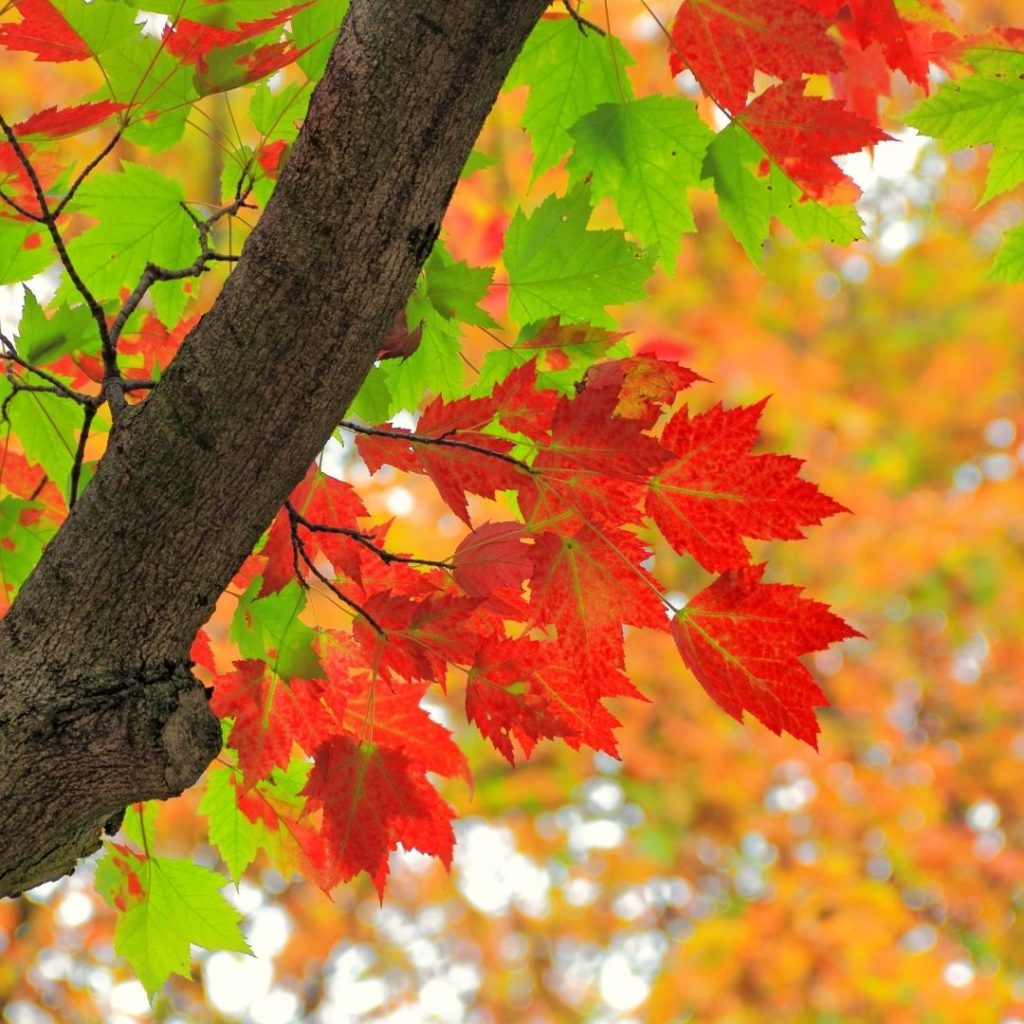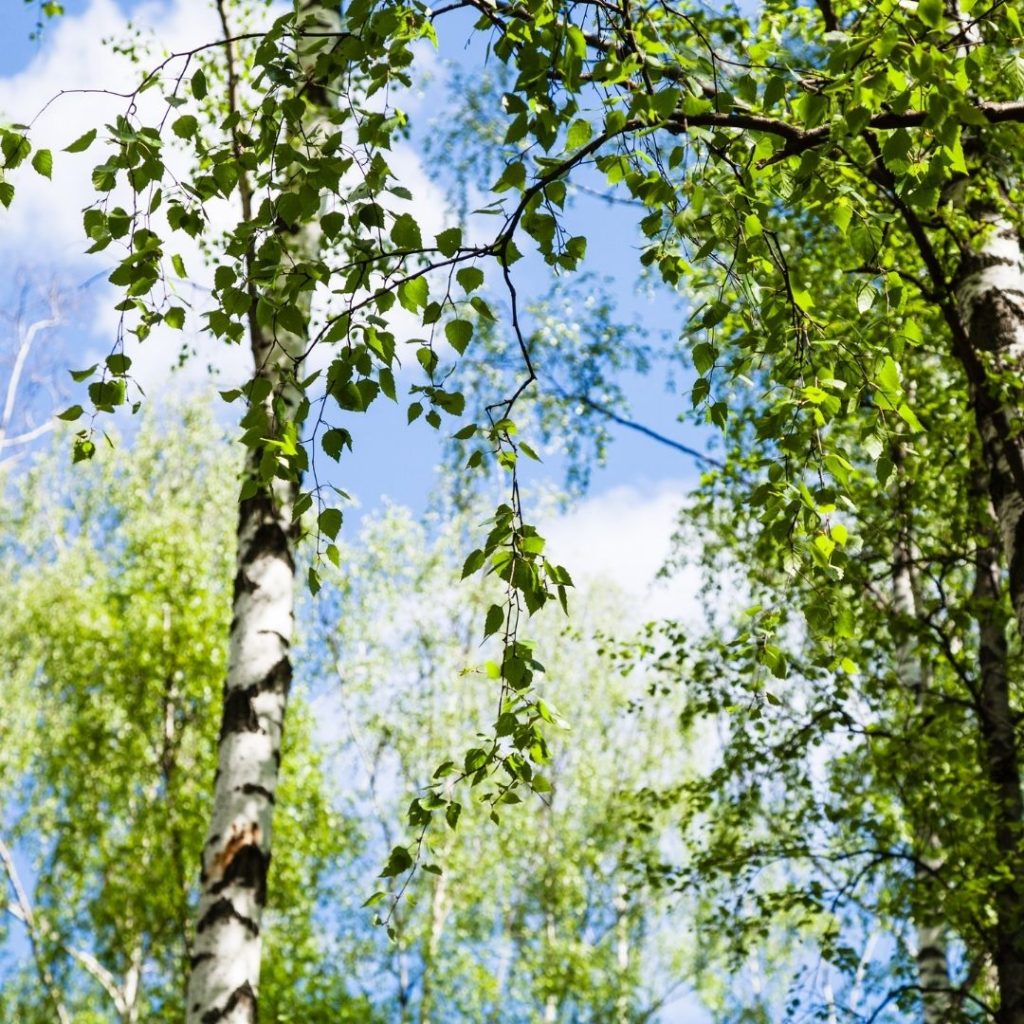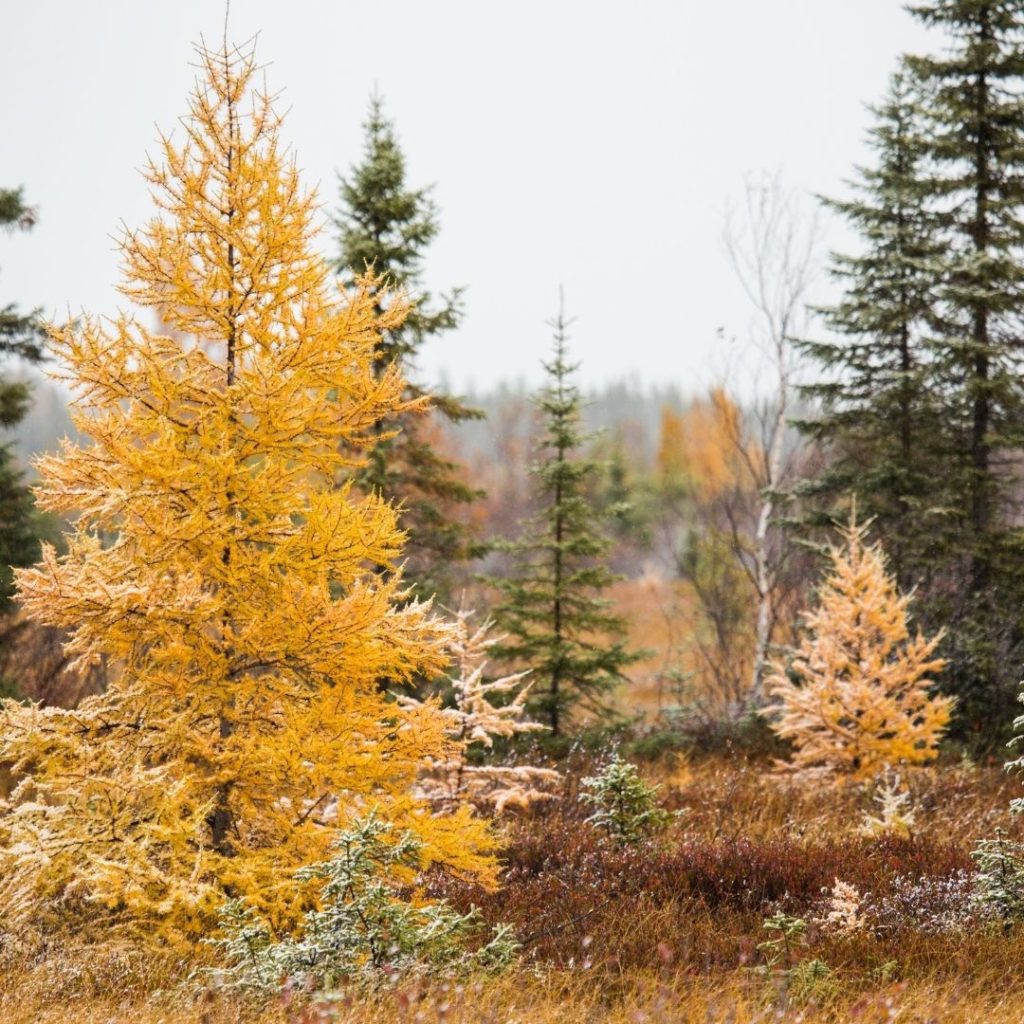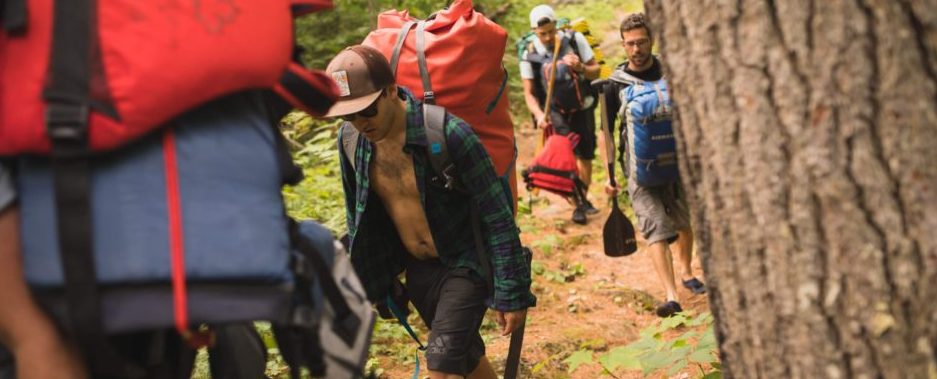Welcome to October and the arrival of peak colour in Algonquin Provincial Park! While the park is beautiful any time of year, it is especially beautiful in autumn when the leaves turn the colour of a blazing campfire. So if you’ve never experienced fall colours in Algonquin, read on and get trip planning!
In this post, we’ll go over our favourite places to see fall colours in Algonquin. We’ve included a mix of hiking trails, lookout points and multi-day destinations. And since we’ve been paddling in Algonquin for more than a decade, we’ve also included some tips on how to make the most of your trip.
So grab a hot beverage and your favourite flannel, and let’s dive in!
Thinking of an autumn canoe trip? Trip Shed hosts a guided canoe trip in October perfect for novice canoeists wanted to explore the park during peak colour. Click here to read more about the trip.
What is the best time to see fall colours in Algonquin?
Before we dive into the specific locations, let’s take a moment to review the best time to see fall colours in Algonquin.
The exact timing for fall colours in Ontario is highly dependent on the area you’re in. Northern latitudes get colder sooner, and as a result, the leaves change earlier in the season. Typically in Algonquin, the leaves begin changing in early-mid September, with the last leaves changing in mid-November. However, the exact time depends on the specific type of tree.
“Peak colour” refers to the time period when the leaves are at their brightest and most colourful. Algonquin is home to more than 30 species of trees, though there are three species we most often include when speaking about peak colour: red maple, poplar and tamarack. The best time for fall colours in Algonquin will be dependent on the type of tree (and colours) you’re interested in seeing.

Red Maple
While red maples have the most spectacular colours, they don’t last very long. “The candle that burns twice as bright, shines half as long”, right? If ensure you visit Algonquin during the peak colours for red maples, check out Algonquin Park’s Fall Colour Report. They post photos each week showing how the colours are progressing and a prediction on when the colours will be at their brightest.

Poplar and Birch
Poplar and birch trees have oval-shaped leaves that shimmer in the wind. During the summer the leaves are soft green, but in early- to mid-October, they change to bright yellow, then gold and finally burnt orange. These colours contrasted with the white and black tree trunks make for a beautiful sight.

Tamarack
Tamarack trees are one of the few coniferous trees that change colour, and they are the only conifer that changes colour in Algonquin. They are scattered throughout the park and you’ll see them changing colour in mid to late October. Tamaracks are especially beautiful when seen popping out between dark green white pines above dark black lake water.
If you need a little refresher: coniferous trees are evergreen trees that don’t (usually) lose their needles in the winter. Deciduous trees change colour and lose their leaves in winter.
Where to View Fall Colours in Algonquin Provincial Park
You can find beautiful fall colours pretty much anywhere in the park. There are, however, a few places that provide an especially beautiful view of peak fall colours in Algonquin Park!
Algonquin Park Visitor’s Centre
Surprisingly, many people who visit Algonquin never make it to the visitors centre and may be unaware that behind this is a great starting point for viewing fall colours. Located at KM 43 along Highway 60, the Algonquin Visitor’s Centre has ecological exhibits, a cafe, a bookstore and – most relevant to our priorities – an observation deck overlooking dozens of maple trees.
During the peak colours in early October, the maple trees change to a vibrant red and stand out from the surrounding coniferous trees. The observation deck is an excellent place to take in the view from above!
Track and Tower Trail
Track and Tower Trail is easily one of the most popular hikes in the park and is one of the best Algonquin trails for fall colours. The trailhead is at KM 25, located in between Canisbay and Mew Lake campgrounds on the south side of Highway 60. It trail is a 7.5 km long loop and requires 255 m of elevation gain.
The trail goes by Grant Lake and Cache Lake, providing views overlooking the lake from above. You’ll be able to see the dark blue water glistening in the sun, framed by yellow, red and green trees.
If you will be staying at a campground along Highway 60, you’ll definitely want to take a few hours to do this hike. Even if you’re just passing through the part on your way to or from an access point, consider making a brief stop for the hike.
The Lookout Trail
Another popular hike is the Lookout Trail. The trail begins at KM 40, just north of Highway 60 near Pog Lake Campground. From the trailhead, there is just 1 km separating you from the viewpoint.
Since the hike is not very long and is well maintained and very short, Lookout Trail is a great option for those wanting to photograph the fall colours at sunset. Just ensure you bring a headlamp, in case it gets dark before you make it to your car.
Centennial Ridges Trail
The third and final contender for the best Algonquin trails for fall colours is Centennial Ridges. The trailhead is located at KM 38 near Pog Lake Campground, just south of Highway 60. The full loop is just shy of 10 km and has about 450 m of elevation gain. However, the main viewpoint is just 2 km from the trailhead so you could shorten the trail if you wanted to.
Centennial Ridges has one of our favourite views in all of Algonquin. The viewpoint shows the curved shoreline of Whitefish Lake and the small, but well forested, island in the centre. The foliage around the lake has a mix of pine, poplar and maple, so you’ll get a different set of colours depending on how far into autumn we are.
Lake of Two Rivers Campground
Lake of Two Rivers is a lake just south of Highway 60 with a large and popular campground here. Lake of Two Rivers is also one of the most photographed lakes in the park – and it’s easy to see why. The land extends beautifully in the water, with pine trees distinctly standing on the tip. This spot is beautiful in autumn when the pine trees are framed by red, pink and yellow maple trees.
Unlike the two destinations above, Lake of Two Rivers does not require hiking to. If you’re an aspiring photographer and don’t want to lug around your camera equipment, Lake of Two Rivers is perfect for you. You can park near the lake, take your camera and tripod to the water’s edge and spend time playing around with angles and compositions.
Backcountry Trips from Lake Opeongo and Canoe Lake
If you have multiple days to spend in Algonquin, consider a multi-day canoe trip departing from either Opeongo Lake or Canoe Lake. Both of these access points are easily accessed off of Highway 60 and have outfitters from whom you can rent canoes and gear.
Both access points have excellent options for multi-day canoe trips. For example, Canoe Lake to Burnt Island Lake for beginners or Opeongo Lake to Hogan Lake for intermediate paddlers.
If you’re a total beginner, we recommend starting out with a guided canoe trip if you’ll be going in autumn. During this time water temperatures are much colder and it’s more important that your group has backcountry experience. If you’d like to learn more about guided trips, please get in touch with us!
Barron Canyon
Most people don’t consider the east side of Algonquin for fall foliage, as the area is primarily dominated by coniferous trees (that don’t change colour in autumn). That said, Barron Canyon is still a great place to catch the yellow hues of birch trees framing the iconic canyon (and avoid the crowds along Highway 60!).
Barron Canyon sits in the northeast corner of Algonquin Provincial Park and is best accessed from Achray Campground access point. There are a few ways to experience the canyon.
First, you can paddle through the canyon. A common route would begin at Achray Campground and go through Grand Lake to Stratton Lake. Alternatively, you could hike the Eastern Pines Backpacking Trail. This would give you an up-close look at the fall foliage.
The most popular option, however, would be to hike the Barron Canyon Trail. The trailhead is located at KM 29 of Barron Canyon Rd, about 11 km past Sand Lake Gate. The trail goes to a lookover above the canyon and is 1.5 km round trip, with 140 of elevation gain, making it suitable for all levels of hikers. The trees around the lake are mostly pine trees (which don’t change colour) with birch trees poking through in a display of bright yellow.
Tips for Viewing for Colours in Algonquin
Now that you know where to go in Algonquin for incredible fall foliage, here are a few tips to help you make the most of it.
Remember that the days are shorter
If you want to capture the golden hour glow, keep in mind that sunrise is later in the morning and sunset comes much sooner in the evenings. Check the sunrise/sunset times ahead of your trip. If you’ll be catching the sunset, bring a headlamp in case it gets dark while you’re out.
Play around with photography
Autumn is a great time to experiment with different compositions and photography techniques. Try using a single, colourful leaf as a subject, or try using the leaves of a maple tree to frame the photo. You can also play around with colour and contrast by photographing a single, colourful deciduous tree in front of a forest of coniferous trees.
If you have more equipment, consider bringing a tripod to help you capture the wispiness of lake water or bring a wide-angle lens if you’ll be doing one of the lookout hikes.
Be safe on the water
If you’ll be canoeing, keep in mind that water temperatures are already dropping. Since water transfers heat 25x faster than air, cold water will cool you down significantly faster than cold air does. As such, be extremely cautious when canoeing in autumn. Wear a life jacket and clothing you could easily swim in. Bring extra clothing and everything needed to build a fire quickly. Also refresh your knowledge on treating hypothermia and canoe-over-canoe rescues. Above all, be smart on the water!
Avoid visiting on weekends
Since the period for peak colours is so short, there are a few weekends when everyone comes to see fall colours in Algonquin. The park gets very busy and you can expect to see lots of people on the trails and on the side of the road. Traffic along Highway 60 will be moving at an all-time slow.
If you can afford to take a vacation day, consider visiting on a weekday. The park will be less busy and you’ll have a more pleasant experience. If you can swing the day off, try to come early in the morning.
Be Careful Stopping on the Highway
Inappropriate vehicle stopping is one of the contributors to Highway 60 congestion. Someone sees a moose or a beautiful red maple and stops their vehicles on the side of the road (usually all the way off the road, but not always). Other cars slow down, perhaps they stop too. Fast forward and you’ve got half a dozen cars pulled over on either side of the road or potentially blocking parts of the road.
If you are going to pull over on the side of the road ensure you do so safely. Check there are no signs prohibiting stopping and that there is clear visibility in either direction. Bring your car fully over the road and onto the shoulder. And don’t J-walk across the road – it is a highway, after all!
In Conclusion
We hope this post has given everything you need to know about planning a trip to Algonquin this autumn. Algonquin is one of the best places to view fall colours in Ontario and we’re confident you’ll have an excellent time. Have a wonderful trip!



